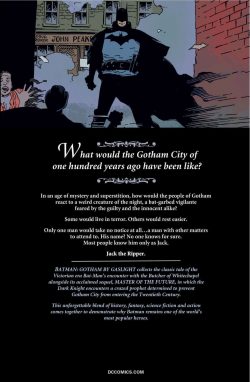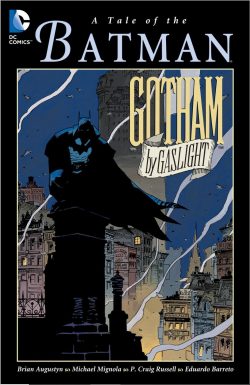

By Brian Augustyn, Michael Mignola, P. Craig Russell & Eduardo Barreto (DC Comics)
ISBN: 978-1-4012-1153-0 (TPB/Digital Edition)
We lost another great in February, albeit an unfairly unsung one. Although a brilliant writer in his own right, Brian Augustyn (November 2, 1954-February 1, 2022) was mostly remarked upon for his scripting collaborations, or perhaps by the more astute for his work as an editor. He began in that role at NOWComics in 1986, on Trollords, Syphons and Speed Racer, before moving to DC in 1988 to edit the weekly Action Comics, the Impact Comics line, Justice League and most notably The Flash. He formed a writing partnership with Mark Waid, encompassing The Flash, Impulse, JLA: Year One, The Comet, The Crusaders, Event Comics’ Painkiller Jane and Ash: Cinder and Smoke, Valiant’s X-O Manowar and most recently the magnificent Archie 1941.
On his own, he scripted Black Condor, Black Mask, Marvel’s Imperial Guard, Out There, Crimson, Mega Man, Amped (in Giant Comics) and the landmark concept/character which forms the basis of this this memorial.
Brian Augustyn died from a stroke on February 1st.
Originally released in 1989 as a 52-page prestige-format (glossy paper, cardstock covers better printing) one shot, Gotham By Gaslight was a sensation. Offering an alternate history for Batman in a chillingly familiar scenario and locale it opened the doors for similar experimentation with all DC’s other properties and directly led to the formation of an eclectic publishing imprint for all such out-continuity “Imaginary Storiesâ€: Elseworlds. As well as opening the doors of creativity, it also fostered crossovers with other companies’ properties, by giving fans a handle to hang such non-canonical stunts on…
From 2013, this edition combines the classic Gotham By Gaslight with its cruelly neglected sequel Master of the Future.
The conceit of the landmark first story is the transposition of the most recognisable icons of the Batman mythos to the end of the 19th century, enabling troubled millionaire and would be avenger Bruce Wayne to begin his shrouded career in gory battle with the world’s most famous serial killer: Jack the Ripper.
Augustyn’s moody, edgy and so-broodingly steam-punk script was elevated to spectacular heights by the astounding artwork of comic giants Mike Mignola & P Craig Russell, and the results have long been considered one of the comic’s high points ever since.
Which in some ways is a shame, as Master of the Future is in many respects a better story. Augustyn finds space and time to flesh out Wayne’s character and show him as an individual, not a transplanted clone of the man we all know, and the drama is gilded by the superb and criminally unappreciated art of Eduardo Barreto splendidly recreating the turn of the (20th) century technological wonderment of Jules Verne (specifically Robur the Conqueror/The Clipper of the Clouds and Master of the World).
Here, as prototypical Mad Scientist Andre LeRoi threatens to destroy the burgeoning metropolis of Gotham City from his airborne dreadnought, only the by-now-disenchanted Batman could possibly stand against him… if he can be bothered.
Augustyn’s intriguing examination of vigilante motivation once the transformational forces of grievance and anger are expiated, especially in an era and milieu of extreme wealth and privilege, provides an interesting counterpoint to the mind-numbing obsession of the “real†caped crusader.
Batman was voted the most popular comic character of the 20th century. How strange, then, that two of his best escapades deal with the age before then and are directed by someone you probably never heard of? How about judging for yourselves with this superb collection?
© 1989, 1991, 2006 DC Comics. All Rights Reserved.
